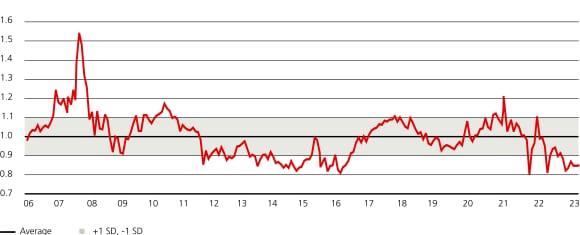Can Chinese equities withstand a slowing economy?
China’s multi-decade period of high growth has come to an end, but the opportunities for investors have not, argue Evan Brown and Sylvia Liang.

China’s structural economic issues are no secret. They have been well-documented and follow a long stretch of exceptional growth driven by huge investments in property and infrastructure, as well as a competitive export sector.
The “Four Ds”– coined by the Council of Foreign Relations’ Zongyuan Zoe Liu – are a useful frame… of reference for understanding the country’s interconnected economic challenges.1
Demand
Demand
China’s consumption share of GDP is 38%, well below the OECD average of 60%. As the property sector and broader investment slow, consumption will need to pick up the slack. But amid a property downturn, household deleveraging, shaken confidence post-COVID, and a reluctance to provide much direct support for consumer spending, catalyzing this transition will be difficult.
Demographics
Demographics
An economy’s long-term growth is driven by productivity and the labor force, but China’s population is now aging rapidly. This weighs on growth and also limits the household formation necessary to support the property market, and by extension, local governments’ revenues.
Debt
Debt
Property developers, local governments and many households need to de-lever considerably as the housing market adjusts. While China’s federal government debt load is approximately 50% of GDP, taking into account local government debt this rises to above 120%, according to Bloomberg and Morgan Stanley estimates. This limits the ability to provide some fiscal cushion to offset broader de-leveraging.
De-risking
De-risking
Western governments’ restrictions on technologies and global multinational companies’ realignment of supply chains is a headwind to growth. Foreign direct investment flows to China have declined to a 26-year low, a sharp reversal from the peak reached in 2021.
Secular opportunities
Secular opportunities
However, we believe negativity on the macro backdrop has led to an underappreciation of China’s secular opportunities.
Firstly, policymakers are taking steps to stabilize and smooth out the slowdown and even as China’s expansion moderates, the growth rate is still projected to outpace that of the global economy over the next five years.2A key reason why earnings growth often doesn’t map cleanly to economic growth is because of the ability for domestic champions to become multinational powerhouses and generate outsized profit growth.3 This is where China has the potential to excel, with multiple industries and companies showing remarkable innovation and growth.
A string of successes on the micro level may be needed for China's markets to reach their potential. Crucially, the nation is still well-positioned to capture meaningfully larger value in the global supply chains by transitioning from “factories” to “globally recognized competitors,” as has been the case in industries such as:
- Home appliances: The international segments of Haier and Midea currently represent nearly 50% of the group’s revenue, outstripping the growth of their domestic segments. China can now compete more on quality against European, Korean, and Japanese brands after having previously only been able to compete on price.
- Consumer electronics: Chinese smartphone brands have captured ~35% of global market share and are growing exports rapidly. Firms like Xiaomi have leveraged the supply chain developed when global leaders like Apple and Samsung manufactured products in China for access to the domestic market and then moved up the value chain.
- Electric vehicles: Chinese electric vehicles are supported by world-class battery R&D and manufacturing capabilities after Tesla established factories and drove EV adoption locally. UBS Investment Bank estimates that China could see their global market share double from 17% to 33% by 2030, largely at the expense of Europe. China employed around 5.4 million people in renewable energy in 2021, which is more than the US, EU, South America and Africa combined.
In addition to these more well-known sectors, the Chinese government is making aggressive investments into advanced technology to ensure self-sustainability and develop global leadership. According to the National Bureau of Statistics, fixed asset investment in high-tech industries where China hopes to move up the value chain rose 12.5% in the first half of this year compared to the same period in 2022. This compares to a 3.8% increase for fixed asset investment as a whole.
In one respect, part of the “de-risking” headwind for China is an implicit acknowledgement of the economic progress already made, and provides additional incentive to prioritize developing expertise in high-tech and other industries that have geostrategic importance. Such rapid technology upgrades, combined with the existing vibrant supply-side ecosystems, best-in-class public infrastructure, and state support are likely to lead to a persistent increase in advanced manufacturing sites in the country.
Examples of this progress include:
- Industrial automation: Chinese companies installed 168 thousand industrial robots in 2020, compared with 68 thousand in Europe and 31 thousand in the US, according to International Federation of Robotics. The application of automation should be productivity-enhancing and help offset some of the downward pressure on growth coming from demographics.
- Patents and entrepreneurship: Ranked 11 in the Global Innovation Index in 2022, China also has the most global patent filings and is home to the most technology unicorns.
- Less-visible sectors: Precision manufacturing in lasers, silicon carbides and opto-electronic components, as well as in industrial equipment and alternative energy. Many of these areas enable Chinese companies to be a more entrenched, essential part of supply chains and grow market share in fast-growing industries, helping to offset some of the “de-risking” impulse.
- Other niche sectors: Advanced radio-frequency communication, hydrogen and ammonia for energy, synthetic biology, and photonic sensors. These seemingly “niche” areas may support longer-term upgrades in key strategic sectors including power, communication, computer science and life sciences.
The potential for rapid growth in high-margin, advanced technology industries provides fertile ground for alpha opportunities in stock selection. This is particularly the case as the Chinese market has not been particularly well-covered by analysts relative to developed market counterparts.
What is in the price?
Unsurprisingly, the significant economic headwinds have not gone unnoticed by investors. And the inexpensive valuations of Chinese equities imply that much of the negative news appears to be priced in.
Valuations are inexpensive relative to other emerging market peers. China is trading before 12-month forward price-to-earnings ratio of 9.8, a significant discount to MSCI World Index, as of November 1, 2023. We anticipate domestic households’ asset allocation will shift towards publicly traded equities over time, as is typically the case when economies mature.4 Furthermore, the slump in real estate is likely to reduce the appeal of this investment vehicle for domestic investors. This could shift relative investment preferences and flows in favor of public equities.
Chart 3: China trades at a significant discount to MSCI World
MSCI China 12m forward P/E relative to MSCI World

Our five-year capital market expectations point to prospective returns of 8.2% per annum for Chinese equities, well above the 6.3% estimate for global equities or 4.2% forecast for US large-cap stocks.
Encouraging signs
No doubt, the Chinese economy has underwhelmed in 2023, and faces considerable challenges in the years ahead to transition away from its credit-fueled, property-centric growth model.
At the macro level, we have confidence that policymakers will provide sufficient support to manage this cyclical slowdown. Economic data from August through October broadly supports the idea that activity has stabilized amid measured fiscal and monetary stimulus, and forecast revisions for Chinese growth are beginning to move higher. On the micro level, we are encouraged by the many ways China has moved up the value chain during its economic development, as well as its potential to be a global leader in a suite of nascent, fast-growing industries.
We are encouraged by the many ways China has moved up the value chain during its economic development, as well as its potential to be a global leader in a suite of nascent, fast-growing industries.
This policy focus on innovation to develop expertise in relatively new advanced technology areas, coupled with low valuations for domestic stocks, give us confidence that Chinese equities will be able to perform well even as economic growth moderates.
Footnotes:

The China complex
The China complex
This special edition of Panorama is dedicated to China and offers a richer way of looking at it from the geopolitical, sustainable, economic and market lenses.
About the authors
-

Evan Brown
Head of Multi-Asset Strategy
Evan Brown, CFA is Head of Multi-Asset Strategy in the Investment Solutions team at UBS Asset Management. In this role, Evan drives macro research and tactical asset allocation investment process for over USD100 billion in client portfolios. Additionally, he is responsible for advising UBS Asset Management’s global institutional and private wealth client base on the macroeconomic outlook and asset allocation.
-

Sylvia Liang
Research Analyst
Sylvia Liang is a Research Analyst and Macro Strategist in the Investment Solutions team at UBS Asset Management, based in New York. She drives emerging markets investment research for multi-asset portfolios and supports senior portfolio managers on tactical asset allocation decisions. Prior to that, Sylvia worked at J.P. Morgan Global Markets and Deutsche Bank Investment Banking in New York. Sylvia is a CFA charterholder and earned a Master’s of Science degree from Columbia University and a BBA degree from Emory University.
Make an inquiry
Fill in an inquiry form and leave your details – we’ll be back in touch.
Introducing our leadership team
Meet the members of the team responsible for UBS Asset Management’s strategic direction.


